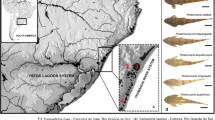Abstract
The existence of the Artemia species typical of Tunisia was proposed for the first time by Clark and Bowen in 1976, and namedA. tunisiana on the only evidence that bisexual individuals from Chott Ariana (Tunisia) proved infertile when crossed toA. franciscana Kellogg. No other informations were then available, including the chromosome number. The brine-shrimps from another tunisian locality (Sfax) where then crossed toA. franciscana Kellogg,A. persimilis Piccinelli and Prosdocimi andA. salina Leach and a complete reproductive barrier was found (Rodinòet al., 1986). Now we have determined the chromosome numbers (42–44) and the resting stage structure of the population of Sfax, which exhibits a low number of chromocenters. We are, therefore, in the condition to propose the existence at Sfax of a local species, which could be namedA. tunisiana. For a definite conclusion it should be necessary to extend the investigations to the population of Chott Ariana.
Riassunto
La specieArtemia tunisiana fu proposta da Clark e Bowen nel 1976 sul solo dato dell’esistenza di una barriera riproduttiva fra la popolazione bisessuata della salina di Chott Ariana (Tunisia) eA. franciscana Kellogg, che non fu però riscontrata con l’artemia della Sardegna (A. salina Leach). Non fu studiato né il numéro cromosomico né la frequenza dei cromocentri. PertantoA. tunisiana fu considerata una specie dubbia. Non è stato possibile ottenere cisti da Chott Ariana, ma un’altra popolazione della Tunisia (Sfax) dimostrò di essere separata da barriera riproduttiva delle tre specieA. franciscana Kellogg,A. persimilis Piccinelli e Prosdocimi, eA. salina Leach (Rodinoet al, 1986). QuestaNota descrive per la prima volta la cariologia delléartemia di Sfax: i cromosomi sono 42 e 44 e i cromocentri sono piccoli e presenti con bassa frequenza (3.92 ± 0.30). Pertanto possiamo affermare che in Tunisia vive una specie locale che può essere denominataA. tunisiana. Ricerche future potranno dimostrare se la specie di Sfax è anche présente a Chott Ariana, e risolvere così il problema della nomenclatura secondo Clark e Bowen.
Similar content being viewed by others
References
Barigozzi C., 1989.Cytogenetics and speciation of the brine-shrimp Artemia. Atti Acc. Lincei Mem. fis., s. 8, v. 19, sez. III: 58–84.
Barigozzi C., Baratelli Zambruni L., 1981.Presence and absence of chromocenters in populations of Artemia. Atti Ace. Lincei Rend. fis., s. 8, v. 71: 122–125.
Clark L., Bowen S., 1976.The genetics of Artemia salinaVII. Reproductive isolation. J. Hered., 67: 385–388.
Rodinò E., Varoutto V., Battaglia B., Barigozzi C., 1986.Further evidence of genetic differentiation among geographic populations of gonocoristic Artemia. Atti Acc. Lincei Rend. fis., s. 8, v. 80: 602–607.
Author information
Authors and Affiliations
Additional information
Nella seduta del 9 maggio 1992.
Rights and permissions
About this article
Cite this article
Barigozzi, C., Baratelli, L. & Barigozzi, S.C. New data for defining the speciesArtemia tunisiana Clark and Bowen. Rend. Fis. Acc. Lincei 4, 39–42 (1993). https://doi.org/10.1007/BF03001182
Issue Date:
DOI: https://doi.org/10.1007/BF03001182




